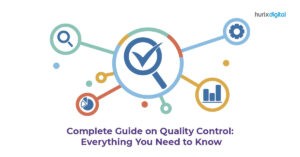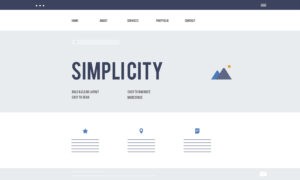Free Website Launch Checklist 2025
Some Important Things to Check Before Your Website Launch:
Before you launch your website out into the world, there are some key actions to take to increase the chances that your audience will find your website in the first place on any popular search engine and that when they do, they will take the actions you want them to take. In 2022, there are a lot of things to consider. You need to make sure your site is ready for success in the current situation.
Follow the steps on this website launch checklist to help you avoid mistakes that can turn your audience off or even prevent them from finding you in the first place. This is very similar to the checklist I follow for every site designed by 360 Interactive.
1. Do Your Quality Control

Making a good first impression with your site has a lot to do with elegance—how it looks, reads, and feels. This means your messaging and the colors that support them are important to consider. - Take time to make sure it doesn’t have any embarrassing or avoidable mistakes:
-
Make sure your site title and description are set and that your logo displays correctly.
-
Check fonts, sizes, colors, and other details and ensure consistency.
-
Read through all pages and ensure there are no spelling mistakes, typos, broken links, or dummy text.
-
Make sure your contact details (phone, email, address) are all correct.
-
Test your navigation and make sure all links are working and go to the correct pages.
2. Test Your Website Functional Elements
Beyond appealing, it’s important to ensure that your site functions well. If you’re an eCommerce site offering customer support, check your user communication experience. Make sure all the functional aspects of your website work exactly the way you expect them to:
-
Test all of your website forms and make sure they behave as expected and that submissions go where you expect them to.
-
If you have email sign-up/newsletter forms linked to your email marketing platform, make sure that the connection is working.
-
Make deliberate mistakes when filling in your forms and make sure that error messages are clear and understandable.
-
If your site is eCommerce-enabled, place some test orders.
3. Optimize Your Mobile

Your website will hopefully be viewed by people on all sorts of devices, using many different browsers. So, whilst you may have viewed it primarily on your own mobile or laptop with your preferred browser during the design phase, you do need to make sure it looks consistently good across ALL platforms and devices before going live.
4. Browser Compatibility Testing
Not only do people visit your site via various devices, but they also use different browsers. According to statistics, Chrome is the most popular browser. Still, many people use Safari, Firefox, or another one. What you need to do is check if your website displays correctly on each of them. The very least you can do is to test it yourself. Use Chrome, Safari, and Firefox (both on desktop and mobile) to make sure everything is in order.
Naturally, you can’t test every single device or browser out there. That’s why you can use these two sites to help you out.
5. Make sure every page has a call-to-action button.
This is a good time to take a small step back and remind yourself why you wanted a website in the first place. What do you want your site visitors to do? Are you trying to sell your services? Do you want them to book an appointment, read your blog, or sign up for your newsletter? Whatever it is, they’re more likely to do it if you explicitly ask them to. So make sure you are signposting and that every page has a clear call to action.
6. Enable a Cookie Banner
By law, if you collect cookies from visitors to your website, you have to enable a cookie banner or pop-up that allows visitors to provide their consent for you to do this. While you’re at it, make sure your privacy policy (and returns policy and T&Cs for e-commerce-enabled sites) are easy to find.
7. Upload a Professional Favicon
A favicon is a little icon that you see next to your site’s name in the tab of a web browser or in bookmarks; it represents your brand. a simple version of your logo. Although it’s a small element, it can help your website stand out in a sea of open browser tabs, so you definitely want to add it. Google also displays favicons on the mobile search results page, which can raise the visibility of your brand there.
These tools can help you create a favicon if you don’t have one already.
If you don't know how to add a favicon, ask your web designer to add one.
8. Add the Sharing Buttons and Connect Social Media
And of course, add links to all of your active social media accounts (but only the active ones, please!), so that your website visitors can interact with you across all their favorite social channels. There are so many social icon sets available, and you can have them as subtle or bold as you like. Just make sure they are visible, link to the right accounts, and preferably open in a new tab, so that visitors aren’t taken away from your website down a Facebook black hole!
Social sharing is used mostly for blog posts. These icons at the bottom of each post enable your visitors to share your articles to different social platforms at the click of a button. By having these enabled, you will increase your chance of being shared and growing your audience by word of mouth. If your site is eCommerce-based, or you show a lot of product photos, you might also want to include a Pinterest share button on certain pages. This will allow visitors to ‘pin’ products they love and increase the visibility of your items to a whole new audience on Pinterest.
9. Optimize for SEO

Google uses more than 200 factors to rank a piece of content. Of course, not all are obvious, but following some key guidelines will help you to rank. At a basic level, every page should include a meta title (around 40-50 characters) and meta description (no more than 110 words). These are the first pieces of content rendered when search engine bots and crawlers explore your website and subsequently define how relevant your pages will display within search results.
10. Create Policies
There’s no doubt the COVID-19 pandemic has changed the way we do things.
To give maximum reassurance to your customers that you’ve got their safety in mind, make sure to draw up a set of policies. Your COVID-19 policy should highlight what procedures you’ll implement across your service to protect your customer’s products, from package handling to delivery. Will you ensure hygiene standards and social distancing measures? Get it written and make it clear on your site.
11. Connect Google Analytics

While platforms like Shopify and Squarespace have built-in analytics, which are perfect if you’re just starting out, when you’re ready to dive deeper into how visitors are using your website and which of your marketing campaigns are really working, you’ll want to have access to Google Analytics (GA). First, you’ll need to create an account with GA, and then you can set it up on your website. With GA installed, you’ll be able to see how many people are visiting your site, where they’re coming from, what devices and browsers they’re using, which pages they’re visiting, and much more. For eCommerce sites, you can set up goals, track sales funnels, view shopping cart drop-off rates, and more.
12. Ensure your website security
Around 70% of website professionals are concerned about potential cyberattacks on websites. Secure Socket Layer, or SSL certificates, are completely mandatory if your website collects any personal information or if you are doing e-commerce transactions, but they are also fast becoming very important for all other websites too. Google has confirmed that SSL certificates are an important ranking signal (ranking signals determine where your website fits in the Google search results for specific search terms), and many browsers will actually flag your website as insecure if you don’t have an SSL certificate—which won’t exactly instill confidence and trust in your audience. Most hosts offer a free SSL certificate—ask yours if you’re unsure.
This means you must do everything you can to protect the security of your website and the data of your customers. It's very important for your business in the long run.
13. Submit your website to Google and another major search engine.
As of mid-2021, Google has an almost 88% share of the search market, so when you launch your website, you’ll want to make sure the world’s most-used search engine knows how to find you. Speed up the process of getting indexed by Google by asking Google to look at your website sooner rather than later. To do this, just search ‘Submit URL to Google’ and follow the steps. Within a few days, you should see your pages indexed in Google. Yay! People can find you now.
If you have any questions about this website launch checklist or are looking for help after you launch a website, feel free to contact us today! We would love to help set you up for success.
How to setup Squarespace SEO 6 Easy Steps

Everyone wants to rank first on Google for their own keyword as soon as they create a professional website, but here’s something you should hear firsthand. It’s not possible right away. Search engine ranking is something that improves over time based on your SEO work, website visitors, bounce rate (how often people click back from the search engine without exploring your site), and even your social media presence. The good news, however, is that despite these issues, Squarespace does a lot right when it comes to SEO, and it is perfectly possible to optimize a Squarespace page effectively for search and to achieve a high ranking for it.
Squarespace is a great option if you have a basic understanding of the process of SEO. Not you? Then get ready to learn everything you need to know about Squarespace and SEO best practices in this guide.
Step 1: Create an ‘SSL’ version of your site

Using HTTPS for your website is now an absolute requirement. If you don’t use HTTPS, Google actually gives your website visitors a warning that your website is not secure. So let’s get that SSL installed (it’s free and super easy on Squarespace). Go to SETTINGS > SECURITY & SSL and click the radio button beside SECURE (PREFERRED).
Step 2: Simplify URLs
Clean URLs are short, simple, and intelligent. As an example, if you were selling red guitars, it would be advisable to use a URL of "www.yourdomain.com/red-guitars" rather than "www.yourdomain.com/prd/p223.php?ref=1456_red_gtr."
It’s very important that all of your website links are clean. If you accidentally made 2 home pages and then removed one, make sure the link on the one you’re using isn’t "/home-1.”.
Step 3: Ensure you’re formatting your website title and description correctly
One of the most essential elements of a web page is its title tag—search engines treat it as a key piece of information when indexing a page, and your title shows up as the largest component of a search result (as well as at the top of browser windows). So, you should ensure your page and post title tags are never vague, and ideally, start with your ‘focus keyword'—the phrase you want to rank for in search.
To edit this, head on over to SETTINGS > BASIC INFORMATION and fill it into the field for SITE DESCRIPTION. Also, copy and paste the same text into SETTINGS > SEO and the SEARCH ENGINE DESCRIPTION field.
Step 4: Setup Image alt text properly
There are many reasons why you should add alternative text to your images. Search engines use it to categorise your content, and additionally, if your image fails to load, a description of it will still be displayed for your site user.
The first thing we want to do is for every image we upload, add a custom filename. Put keywords into this filename as well, so something like “Squarespace-SEO-for-images.jpg” if those are the keywords you want to rank for. Also, make sure you insert a caption. You can hide the caption by changing it from CAPTION BELOW to DO NOT DISPLAY CAPTION, but always insert a caption even if you’re going to hide it.
Adding alt text to image blocks
To add images to ‘normal’ Squarespace images—i.e., those inserted via the Squarespace ‘image block'—you need to:
-
Hover over the image block and click Edit (or the pencil icon in Squarespace 7.1).
-
Click the Design tab.
-
Click Inline.
-
Ensure that the ‘Caption Below’ option is selected.
-
Add a caption below the image (this caption then becomes the alt text).
-
Click Apply.
Step 5: Add High-Quality content to your site
Search engine algorithms continue to become more sophisticated, so providing quality content is one of the most important factors to rank in search. You must provide exceptional, unique content that answers the questions of your potential customers. Behind every successful SEO campaign is a solid content strategy emphasizing top-notch content. So, focus on quality over quantity.
Step 6: Register and index your website to Google and Bing.
Once your Squarespace site has been designed and optimized for SEO (following the advice above), it’s time to register your site with Google.
Before you do that, there are a few things you need to make sure you’ve done.
If you’re using a third-party domain, make sure it’s connected properly. Squarespace recommends waiting around 72 hours after you’ve connected your domain before you register your site with Google.
You want to make sure you nudge Google and Bing to know that your website is out there! The next step is letting them know.
Do you have a question or concern about Squarespace SEO or need personalized help? Feel free to contact us.
FAQ: Squarespace SEO Setup
1. How do I set up SEO on Squarespace?
To set up SEO on Squarespace, go to Settings > SEO. Here, you can edit your site's title, description, and URL. Make sure your pages and blog posts include relevant keywords, and enable SSL for secure browsing.
2. How do I add meta descriptions to Squarespace?
In the Page Settings of each page or blog post, you'll find an option to add a meta description. This description helps search engines understand the content of the page and appears in search results.
3. Can I customize the SEO for individual pages?
Yes! Squarespace allows you to customize SEO settings for each individual page. Go to the Page Settings, and under the SEO tab, you can adjust titles, descriptions, and keywords specific to that page.
4. Does Squarespace support 301 redirects?
Yes, Squarespace supports 301 redirects. You can set up redirects under Settings > Advanced > URL Mappings to help maintain your site’s SEO if you change URLs or move content.
5. How can I track my site’s SEO performance?
You can connect your Squarespace site to Google Analytics or use Squarespace’s built-in analytics to track your traffic, search queries, and SEO performance.
7 Tips to Make Your Website Better.
Are you ready to take your small business website up a notch? When it comes to small business marketing, a great website can be one of the most effective and cost-efficient marketing channels out there. Your business website is a prime marketing opportunity. Follow these 7 tips to make the most of it.
1. Keep your website design simple, fresh, and unique.

As the first thing potential customers see when they visit your website, the homepage is the most important part of a small business’s website design. Make sure your site homepage answers the critical questions new visitors will be asking, including who you are, what your business is, and what they can do on your website. Consider the impression you want to make and the message you want to communicate with your customers and potential customers.
2. Make your text bite-sized.
One of the best things you can do to make your site more effective is to break down your text into short one- or two-sentence snippets. Keeping the text brief makes it easy to read. The trick is not to overload your homepage, which can be distracting and confusing for customers. Keep it to no more than 120 words of text. Once your text is bite-sized, organize and label it with descriptive titles or headlines to help users quickly scan the page for information that is interesting or relevant to them.
3. Make your site easily accessible.
Consider that people with certain disabilities (such as color blindness) will visit your site, and plan your design so that they, too, can learn about your products and services. Also, consider how people with slower Internet connections will view your site and what you can do to improve their experience.
4. Organize your website to provide a great user experience.
Keep in mind that when your prospective customers visit your site, they’re typically looking for specific information. They’re rarely going to read entire pages, and most people will skim pages quickly. A well-structured site that presents information in an orderly and organized way will be much more successful than one that appears chaotic or that is not intuitively arranged.
5. Test it on the potential customer base.
Show your website to a few would-be customers and get their feedback. Have a few specific questions ready, like:
-
What is your first impression of this site?
-
What does this company do?
-
What problem can this company solve for you?
-
What makes this company better than other alternatives?
-
What next step can you take to work with this company?
The purpose is to get honest feedback on how well your website communicates, so don’t ask leading questions. If possible, test it on people who don’t know that you are working on the website. Otherwise, they may hold back to avoid offending you.
6. Optimize your website for laptops, tablets, and mobile phone users.

Avoid designing pages for a large monitor size or pages that use more complex features such as Flash animation or navigation. Flash isn’t supported on Apple devices.) Keep it simple and clean so your site is optimal for any device a visitor might be using.
7. Don’t forget to do search engine optimization (SEO).
SEO is a highly specialized field and requires a substantial investment of time to learn. But SEO campaigns can provide great leverage to small businesses and, as a result, should not be ignored. There are literally thousands of qualified professionals who can help you with this, and executing your SEO strategy well will have a huge impact on your site’s success.
As you make improvements to your site, it’s important to remember that a website is never really “done.” It’s not a one-time creation that you build and publish and walk away from. It should grow and change with you as your business evolves.
What next step are you taking to improve your website? Also, please Contact Us if you have any questions or need any help to improve your website design
Q&A (Frequently Asked Questions)
Why is a basic website design essential for small businesses?
A simple design allows users to navigate the app easily, find information quickly, and have a positive first impression. Layouts that are far too flashy can intimidate users and reduce the quality of their time on the website.
Are there ways to make my website more accessible?
Use high-contrast colors, put descriptive alt text on images, and make sure your site is keyboard-navigable. Also, compress images and minimize scripts to optimize loading times.
How much text should I have on my homepage?
Keep homepage text to around 120 words. Once again, know that time is of the essence, and the majority of your visitors will prefer to scan the information rather than read it in paragraphs.
How do I get feedback on my website?
Share it with potential customers and test your site. Ask specific questions like:
Why does mobile optimization matter?
As more than 50% of the world’s web traffic comes from mobile devices now, optimizing your website for mobile devices helps your website to work and appear well on all screen sizes. Reserves the user experience and lowers bounce rates.
What are some of the SEO fundamentals that I can apply right away?
- Content with Targeted Titles and Meta Descriptions
- Ensure images have descriptive alt text to optimize them.
- Collaborate with industry-specific websites or directories where you can add backlinks.
Some keys to design a successful squarespace website.
Since founding WEBEFO in 2014 I’ve had the opportunity to build websites for hundreds of awesome clients.
Year to year I’ve noticed trends that come and go, but there are a few timeless factors that affect the success of a website.
Here are some of the most important keys to a successful site:

1. Text that’s easy to understand
The main words you want to use on your website are just as important as the way they are presented visually. There are a few good principles you can follow that will help you get it right:
-
Break up your text into small chunks to add your text to your website
-
Label sections of text with headlines.
-
Use your website text copy your customers are looking for.
-
Avoid insider word or terms that confuse your customer
-
Being clear is more important than being clever
-
Talk about things from your customer’s perspective that will help website conversion.

2. A professional design
Having your website designed by a professional is more important than you think. Here’s why:
Customers will judge you at a glance
If your website looks amateur, customers will assume that your services or the quality of your product are also amateur. Compare it to how our brains assume things about someone by the way they dress. Even though it may be incorrect, our brain often uses the way something looks to make a judgment call instantly.
Great design builds trust and shows legitimacy
When your website looks clean and professional, people are more likely to trust you because they know you’re serious about your craft. Not only does this make people more likely to hire you, but it also makes working with them easier since they will be more likely to trust you as a professional.
You can’t afford to confuse your customers
A professionally designed website will follow usability principles to help organize information in a way that makes it effortless for customers to find what they’re looking for. If people don’t find what they’re looking for quickly, they’ll go elsewhere.

3. A user-friendly website editor
An often-overlooked aspect of having a successful website is the ongoing management plan after the website is built. Having an easy-to-use website editor (CMS) is critical. If your website is too hard to edit, that friction may keep you from getting the most out of your investment moving forward.
Here are a few basic things you should be able to do:
-
Be able to edit your website while previewing your design
(not have to switch between edit and preview modes) -
Edit and update photos very easily.
-
Ability to change text quickly and easily
-
Duplicate and copy your existing design and create new pages easily.
-
Easy to make small changes on your website for mobile and another screen design.
At WEBEFO we’ve chosen to use Squarespace for our clients since it meets and exceeds all of these requirements. We re-evaluate regularly and so far continue to find Squarespace to be the most user-friendly website builder for our clients.

4. Search engine optimization.
When we build a site we follow several best practices to optimize Squarespace websites to be more discoverable:
-
Add a professional site title based on your business or brand type.
-
Add the title for your website on each page.
-
Use Squarespace to recommend URLs strategically.
-
Add custom page descriptions with your required tag.
-
Write alt-text for your website all images
-
Submit to the most popular search engines for indexing your website.
While design trends are fun (and we like to follow them too), keep in mind that there’s more to a successful site than looking good. Clear copy, a professional design, a good website editor, and SEO best practices will get you a long way.
Leave a comment below or let us know if you have any questions Meet WIth Us




